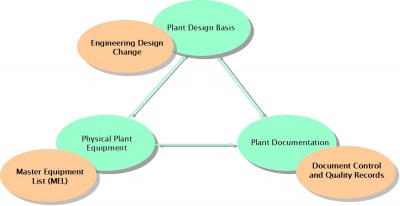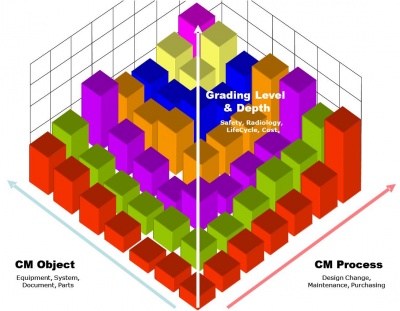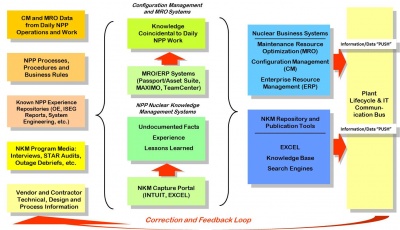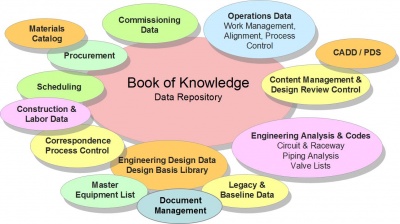Configuration management
Contents
- 1 CM and NKM
- 2 Strategic Nuclear Knowledge Management (NKM) Objectives
- 3 How do CM and NKM support each other?
- 4 Types of Nuclear Knowledge in NPP's
- 5 Nuclear Knowledge Management (NKM) Stages
- 6 CM and NKM Convergence in NPP Operations
- 6.1 Configuration Management and Nuclear Knowledge Management converge in the following NPP processes:
- 6.2 Besides NPP Plant Data, how should these tools for Knowledge Capture and Management be best utilized?
- 6.3 Knowledge Management Systems benefit from NPP CM and MRO systems best when you have the appropriate:
- 7 References
- 8 Related articles
CM and NKM
What is Configuration Management (CM)?
Configuration Management is the engineering concept by where a systematic approach is applied to the correlation of the plant design basis and engineering design changes, the physical plant content and equipment (including components and parts), and the associated documentation. When these three aspects of engineering design agree and are synchronized by content and time, they are said to be in “Equilibrium” (Figure 1). This is a process to maintain an accurate alignment of the plant design bases, the plant administrative records such as procedures, drawings and other records (known as FCI) and what is actually installed in the physical plant. Any ‘mismatches’ of these three categories of information must be evaluated and corrected if specified by the process owner. This process requires the knowledge and cooperation of all employees for success and it is also used to maintain the plant design bases and also to implement plant modifications.
CM is applied according to the impact of equilibrium to a particular discipline or aspect of NPP engineering, maintenance or operation (Figure 2). The amount of CM and Knowledge to be acquired from the process is a direct result of the volume of data and relevance achieved from the data capture.
Source: Planning and Execution of Knowledge Management Assist Missions for Nuclear Organizations
Strategic Nuclear Knowledge Management (NKM) Objectives
Capture, Process and Publish Critical Nuclear Plant Knowledge to:
- Maximize efficiency, minimize rework and increase standardization
- Quickly and easily store and access the right knowledge and data
- Easily identify and access expertise both within and outside the organisation
- Quickly assimilate new acquisitions and make new local expertise available globally
- Learn quickly and in a timely fashion from successes and failures
- Easily retain useful knowledge and avoid “brain drain” as people leave or retire
- Embed Knowledge Management into key work processes to ensure ongoing learning is integral to business and not a “nice to have” bolt on
- Become an organisation where people want to share and create knowledge
How do CM and NKM support each other?
- The convergence of enterprise nuclear MRO and CM information systems with Nuclear Knowledge Management serves as an emerging source for capture and management of key tacit nuclear knowledge.
- Configuration Management Processes and Information Systems are the best source of latent and “passive” knowledge and experience.
- This knowledge is almost always acquired “after” the fact, often unwittingly and without conscious or pre-determined intent to collect it. This is the biggest reason so much Nuclear Knowledge is either lost, or very difficult to find later.
- Like Configuration Management (CM) and MRO, the Nuclear Knowledge Management (NKM) program should be commissioned from the first day of NPP design, through construction, and on through operation.
Types of Nuclear Knowledge in NPP's
Explicit Knowledge from Daily NPP Operations: Information, Facts, Design Data and Operating Experience acquired, reviewed, corrected and verified as part of normal NPP operation, then recorded and documented to maintain plant configuration. This process includes Engineering Design, Parts and Procurement, Work Orders and Maintenance, Health Physics, Quality Systems, and other Configuration Management (CM), MRO (Maintenance Resource Optimization) and ERP (Enterprise Resource Management) nuclear business systems.
Latent or Implicit Knowledge: Information, Experience and Knowledge accumulated over time by personnel, which may or may not have been formally recorded or documented. These may be latent memory items or “tribal knowledge”, or may be contained in NPP documentation but not recognized or identified because it is difficult to locate, not properly tracked by the NPP CM system, or unverified.
Nuclear Knowledge Management (NKM) Stages
NKM Lifecycle: First Day of Design forward though Decommissioning
- Identification of Knowledge Sources
- Collection of Knowledge
- Review/Collation into Meaningful Context and Background
- Storage and Retention of Verified Knowledge
- Publication on Demand (Timely and Easy Access)
CM and NKM Convergence in NPP Operations
Configuration Management and Nuclear Knowledge Management converge in the following NPP processes:
- Configuration Management and Asset Management Data
- Design Basis Library and Repository
- NPP Engineering “content and change history” for NPP Design Basis
- NPP Business Rules and Processes
- Asset, Project and Financial Management
- Safety Impact
- Exposure/ALARA
- Plant Production/Availability
- Component Lifecycle/MRO
- Cost and Physical Asset Management
- Regulatory and Programs
- License Impact
Besides NPP Plant Data, how should these tools for Knowledge Capture and Management be best utilized?
- NPP Legacy Documents and Data
- Apprenticeship Programs
- Information Portals, such as SAP and Sharepoint
- Wiki’s, Blogs, Notes, Discussion Forums
- EDR and Engineering Design Review Process Control
- Plant Life Cycle Management (PLM)
Knowledge Management Systems benefit from NPP CM and MRO systems best when you have the appropriate:
- Technology - Computers, Software, IT Architecture.
- Organization - Bottom-Up Information Flow; Accountability and Sense of Teamwork.
- Processes - Ensures Communication of Knowledge Occurs as Normal Part of Work.
- Procedures - Enforces Organization and Communication Requirements.
- Training - Plant Staff Become Aware of Knowledge Needs and Requirements.
- Work Culture - NPP Personnel Relate to Each Other to Maximize Exchange of Experience.
- Infrastructure - Plant Lifecycle Management (PLM) Integrates Knowledge Exchange into Daily Plant Work.




